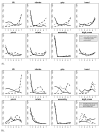Assessing agreement of self-reported and observed physical exposures of the upper extremity
- PMID: 20166314
- PMCID: PMC3579613
- DOI: 10.1179/107735210800546227
Assessing agreement of self-reported and observed physical exposures of the upper extremity
Abstract
Assessment of workplace physical exposures by self-reported questionnaires has logistical advantages in population studies, but is subject to exposure misclassification. This study measured agreement between eight self-reported and observer-rated physical exposures to the hands and wrists, and evaluated predictors of intermethod agreement. Workers (n = 341) from three occupational categories (clerical/technical, construction, and service) completed self-administered questionnaires and worksite assessments. Analyses compared self-reported and observed ratings using a weighted kappa coefficient. Personal and psychosocial factors, presence of upper extremity symptoms, andjob type were evaluated as predictors of agreement. Weighted kappa values were substantial for lifting (0.67) and holding vibrating tools (0.61), moderate for forceful grip (0.58), and fair to poor for all other exposures. Upper extremity symptoms did not predict greater disagreement between self-reported and observed exposures. Occupational category was the only significant predictor of inter-method agreement. Self-reported exposures may provide a useful estimate of some work exposures for population studies.
Figures



References
-
- US Department of Labor. US Bureau of Labor statistics Occupational Injuries and Illnesses: Counts, Rates and Characteristics. Number and incidence rates of injuries and illnesses due to musculoskeletal disorders, by selected occupations, private industry. 2006. Report 1014.
-
- Winkel J, Mathiassen S. Assessment of physical work in epidemiology studies: concepts, issues and operational considerations. Ergonomics. 1994 Jun;37(6):979–88. - PubMed
-
- Spielholz P, Silverstein B, Morgan M, Checkoway H, Kaufman J. Comparison of self-report, video observation and direct measurement methods for upper extremity musculoskeletal disorder physical risk factors. Ergonomics. 2001 May 15;44(6):588–613. - PubMed
-
- Punnett L, Wegman DH. Work-related musculoskeletal disorders: the epidemiologic evidence and the debate. J Electromyogr Kinesiol. 2004 Feb;14(1):13–23. - PubMed
Publication types
MeSH terms
Grants and funding
LinkOut - more resources
Full Text Sources
Medical
